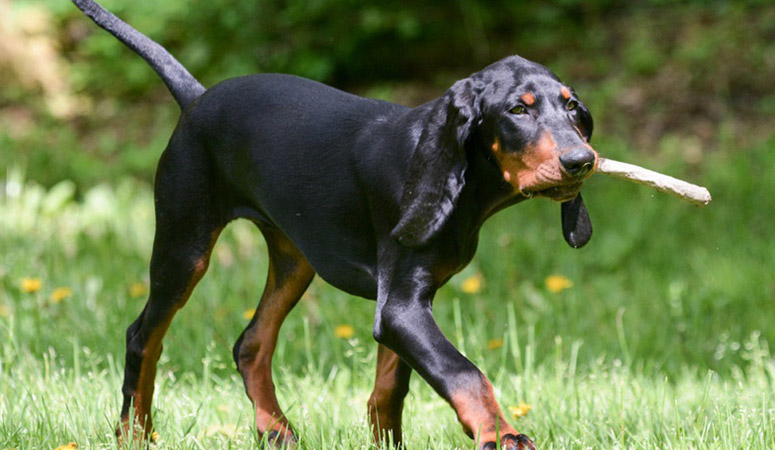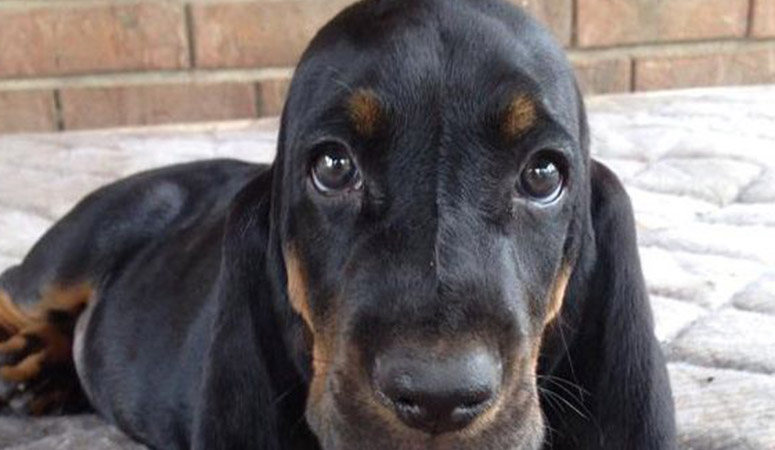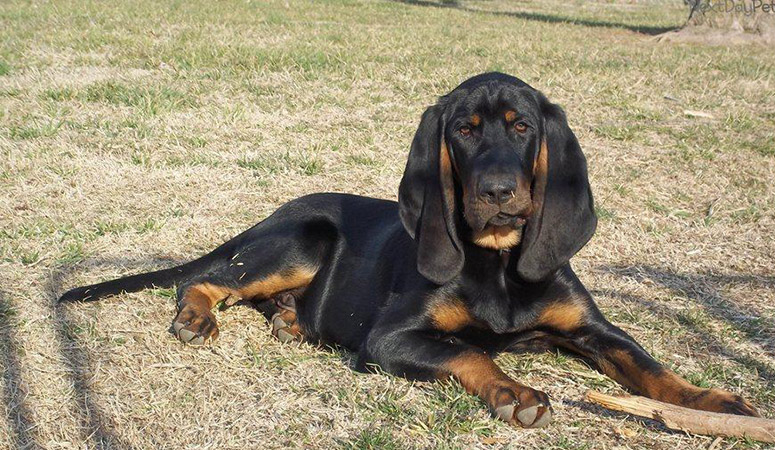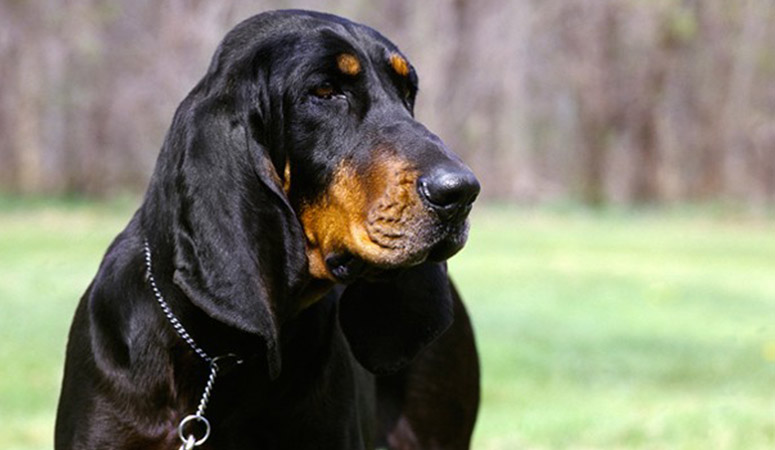Black and Tan Coonhound
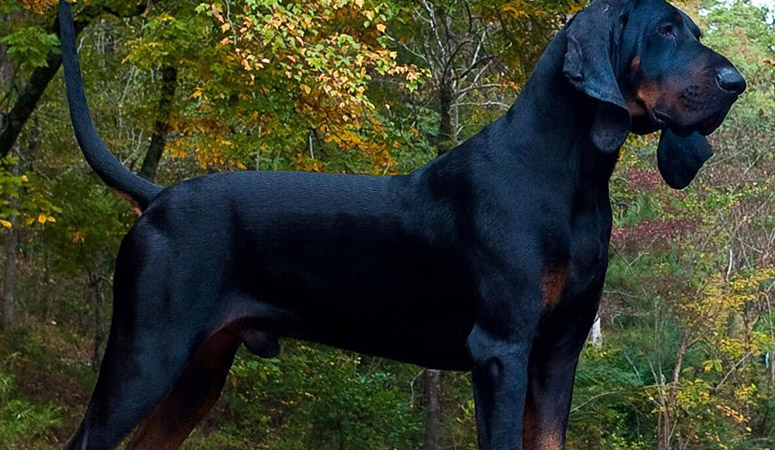
With moderate build, the Black and Tan Coonhounds is a real American original and has great strength, speed and agility. As a large, athletic hunting breed, he has a keen nose and an impressive howl, which also make them fantastic family companions. They work nights, but they might be too much hound for the lifestyle of every owner.
| Other Names | American Black And Tan Coonhound |
| Color | Black & Tan |
| Height | Males: 23-27 inches. Females: 21-26 inches. |
| Weight | Males: 50-75 pounds. Females: 40-65 pounds. |
| Life Span | 10-12 years |
| Personality | Easy-Going, Bright, Brave |
| Exercise | Regular Exercise |
| Origin |
| Popularity | #141 |
| Groom Needs | Weekly Brushing |
| Kids Friendly | Yes |
| Dog Friendly | Yes |
| Watch Dog | |
| Family Dog | Yes |
| Litter Size | 7-8 puppies |
Black and Tan Coonhound Pictures
Black and Tan Coonhound Video
Introduction
The Black and Tan Coonhound is a lovely companion, and a happy dog that loves to show off in the show ring, and if at home, he will make a great playmate for the family. He enjoys brisk walking or running with his owner; and at night keeps you safe as a constant companion. He’s got a deep throaty bark that will let you know someone is around. They’ve got strong hunting instincts and are used to open spaces. This means he needs room for exercising – the garden should be fenced, as he has a tendency to roam. He stands 27 inches at the shoulder and weighs around 100 pounds. He is noisy and will bay and howl if he finds something like a cat or other small animal in a tree that he wants to reach! Another characteristic of this dog that might not appeal to certain people is that he can slobber and drool a lot when hot. Obedience training from a pup is highly recommended for this dog, but don’t count on him being perfectly compliant. They also shed hair quite heavily. His coat needs to be brushed around 2-3 times to distribute the oils and keep his skin in good condition.
Living with Black and Tan Coonhound
With a short, dense coat, the Black and Tan Coonhound needs shedding once or twice a year. Grooming also promotes new hair growth and distributes skin oils throughout the coat to keep it healthy.
Get your Coonhound accustomed to being brushed and examined when he’s a puppy. Make grooming a positive experience filled with praise and rewards, and you’ll lay the groundwork for easy veterinary exams and other handling when he’s an adult.
Black and Tans should be bathed occasionally to keep them from developing a doggy odor. Brush the Black and Tan two to three times a week with a hound mitt or firm bristle brush to distribute skin oils and keep loose hair from floating off the dog and onto your furniture and clothing.
As with all breeds, the Black and Tan’s nails should be trimmed regularly, because overly long nails can cause the dog pain as well as problems walking and running.
Nails should be trimmed weekly or only monthly to keep them short. Short, neatly trimmed nails keep the dog’s feet in good condition and keep your legs from getting scratched when your Coonhound enthusiastically jumps up to greet you. Handle his paws frequently — dogs are touchy about their feet — and look inside his mouth and ears.
Brush your Black and Tan Coonhound’s teeth at least two or three times a week to remove tartar buildup and the bacteria that lurk inside it. Daily brushing is even better if you want to prevent gum disease and bad breath.
Check and clean his long, graceful ears weekly to prevent infections.
Black and Tan Coonhounds require a moderate amount of exercise every day, whether it’s a play session in the yard or a long walk.
With enough exercise, Black and Tan Coonhounds are laid-back indoor companions. If it’s not too cold, he’s with another social dog, and he’s given warm, dry shelter. But if he’s an only dog, he should live indoors with his human pack so he doesn’t get lonely.
Known for mournful-sounding bay and need space to run, they’re not ideal apartment dogs. These hounds were bred to hunt with strong instinct to chase after any small animal they smell, so the yard has to have a tall, solid fence, and the walk has to be on a leash. Keeping them secure is important as their ears often shut off when their nose kicks in. If a Black and Tan catches a scent, he will follow it.
An obvious option for exercise is, of course, a hunting trip, and not just for raccoons—the Black and Tan can be trained to help out hunting just about any kind of game, from squirrels to deer, if local ordinances permit. They also enjoy participating in coonhound field events.
The Black and Tan Coonhound should do well on a high-quality dog food, and the recommended daily amount is about 3 to 5 cups, divided into two meals.
But the amount of your dog diet depends on his size, age, build, metabolism, and activity level. The quality of dog food you buy also makes a difference — the better the dog food, the further it will go toward nourishing your dog and the less of it you’ll need to shake into your dog’s bowl.
Hounds like to eat. And some dogs are prone to getting overweight, so watch your dog’s calorie consumption and weight level. Treats can be an important aid in training, but giving too many can cause obesity.
Clean, fresh water should be available at all times.
Learn about which human foods are safe for dogs, and which are not. Check with your vet if you have any concerns about your dog’s weight or diet.
The Black and Tan Coonhound is typically a sturdy breed with few health problems. Some common health conditions include hip dysplasia, ear infections, blood clotting disorders, working injuries, hypothyroidism, thyroid issues, minor eye concerns and bloat.
Not all Black and Tan Coonhounds will get any or all of these diseases, but it’s important to be aware of them if you’re considering this breed.
The dog’s ears should be checked regularly for signs of infection, and the teeth should be brushed often, using a toothpaste designed for dogs.
There are several health tests considerations specific to the breed, such as hip evaluation, cardiac exam, and ophthalmologist evaluation.
Responsible breeders test all breeding stock for conditions that can affect the breed. Regular visits to the vet for checkups and parasite control help to ensure the dog a long, healthy life.
Total Annual Cost: $3239
Cost is estimated for the first year and may vary depending on many factors, such as dog food, health care, leash, collar, licensing, possible fencing, crates, training and obedience classes, dog-walking, grooming, treats, toys, flea, tick, and heart-worm meds, microchips, etc.
Black and Tan Coonhounds are intelligent, affectionate, and devoted and also have an independent streak. They can be trained, but it’s best to expect compliance rather than blind obedience.
Black and Tans want to be with their families, and a dog left alone in a yard for long periods, bored and ignored, is likely to complain—loudly.
Black and Tan Coonhounds are smart but can be easily distracted. You may get frustrated at its ability to focus on a scent, so work with the dog rather than against its natural tendencies.
Like any kind of larger dog, start training and socialization early. Once they learn to do something, they’ll be inclined to do it that way for the rest of their lives, so it’s important to train the behavior correctly the first time.
If you’re using your Black and Tan Coonhound to hunt, it will require specialized training in scent discrimination. When it comes to obedience training, you’ll need to employ consistent, positive training methods and lots of repetition. Food-motivated Black and Tan Coonhounds will often perform basic obedience requests in exchange for treats.
Bred to work on their own, and don’t necessarily see why they should have to do things your way. On the plus side, they generally housetrain quickly. It is important to crate train your Coonhound puppy. Puppies explore, get into things they shouldn’t, and chew stuff that can harm them. Crate training ensures not only the safety of your puppy but that of your belongings.
They also possess the intelligence and drive to compete in agility and other dog sports. Some Black and Tans have been trained for search and rescue, and they may have the skills and temperament to work as a service animal.
History
The Black and Tan Coonhound’s bloodlines go back to the Talbot hound of a thousand years ago. He’s a creation of the mountain people of the Ozarks and the Smokies.
Even though the direct ancestor of the Black and Tan Coonhound is the English foxhound, the Coonhound breed itself is a uniquely American creation, developed in the mountains of the southern United States in the 1700s.
He was bred to hunt raccoons and possums and proved to be the perfect companion for colonial settlers who created him to be a hunter.
Did you know that the first president of America once, George Washington, was responsible for playing a big role in the development of Black and Tans, making the breed prominent during this term?
Another historical figure who loved Black and Tans was Thomas Jefferson, the third United States president, and like Washington, had his own pack of black and Tan Coonhounds.
If you remember the movie, The Duke, in 1999, it featured a Black and Tan Coonhound called Hubert, where the dog’s loyal and loving nature was showcased.
The American Kennel Club recognized the breed in 1945. A grand name was given to the first Black and Tan Coonhound registered – Grand Mere Big Rock Molly!
Helpful Information
Breed Club: AMERICAN BLACK AND TAN COONHOUND CLUB
Breed Club Link: http://www.abtcc.com/
Breed Club Rescue: AMERICAN BLACK & TAN COONHOUND RESCUE
Breed Club Rescue Link: http://www.coonhoundrescue.com/

